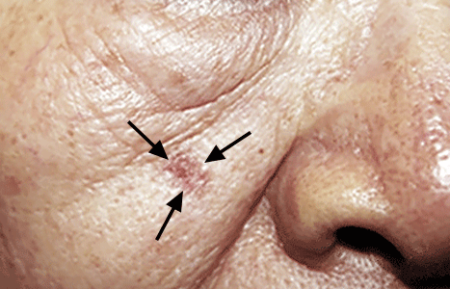Actinic keratosis: Overview
Actinic keratosis
What is actinic keratosis?
Also called solar keratosis, this is a precancerous skin growth caused by the sun or indoor tanning.
Is it contagious? No
What is actinic keratosis?
If you have an actinic keratosis (AK) on your skin, you have one of the most common skin conditions that dermatologists treat.1 It is estimated that more than 40 million Americans develop actinic keratoses (AKs) each year.2
These precancerous skin growths are common because many people seldom protect their skin from the sun with sunscreen, clothing, and shade. Without sun protection, the sun’s harmful rays can damage your skin. While your body may repair some of this damage, the sun’s rays continue to damage unprotected skin. Over the years, this damage builds up and can cause precancerous changes to your skin.
Actinic keratosis
An actinic keratosis often appears as a reddish spot (as shown here) that develops on skin you seldom protected from the sun over the years.

People who use (or have used) tanning beds, sunlamps, or both also get AKs. The amount of the harmful radiation produced by a tanning bed is similar to that of the sun, and in some cases might be stronger.3
AKs tend to appear on skin that’s been the most badly damaged by the sun. That’s why they often appear on the face, ears, balding scalp, hands, neck, or lips. These areas tend to get the most sun.
When an AK forms on a lip, the medical name for this precancerous growth is actinic cheilitis.
Many people who develop AKs and actinic cheilitis are otherwise healthy. They don’t feel ill or rundown.
Still, it’s important to know if you have any of these precancerous growths on your skin. Some AKs and actinic cheilitis turn into a type of skin cancer called squamous cell carcinoma.
Paying attention to your skin can help you find a precancerous growth. This is especially important if you’ve spent a lot of time outdoors without protecting your skin from the sun or used tanning beds.
It may be helpful to know that some AKs look harmless. They can look like a new age spot, pimple, or patch of irritated skin. On the lips, these precancerous growths can look like a badly chapped lip.
You’ll find pictures of the diverse ways that AKs can appear on your skin at, Actinic keratosis: Signs and symptoms.
1 J Am Acad Dermatol 2017;76:958-72.
Image
References
Lim HW, MD, Collins SAB, et al. “The burden of skin disease in the United States.” J Am Acad Dermatol 2017;76:958-72.
Neugebauer R, Katherine A. Levandoski KA, et al. “A real-world, community-based cohort study comparing the effectiveness of topical fluorouracil versus topical imiquimod for the treatment of actinic keratosis.” J Am Acad Dermatol 2018;78:710-6.
Rigel DS, Cockerell CJ, et al. “Actinic keratosis, basal cell carcinoma, and squamous cell carcinoma.” In: Bolognia JL, et al. Dermatology. (second edition). Mosby Elsevier, Spain, 2008:1645-58.
Rigel DS, Stein Gold LF, “The importance of early diagnosis and treatment of actinic keratosis.” J Am Acad Dermatol 2013;68:S20-7.
Rosen T, Lebwohl MG. “Prevalence and awareness of actinic keratosis: Barriers and opportunities.” J Am Acad Dermatol 2013;68:S2-9.
 Think sun protection during Skin Cancer Awareness Month
Think sun protection during Skin Cancer Awareness Month
 How to care for your skin if you have lupus
How to care for your skin if you have lupus
 Practice Safe Sun
Practice Safe Sun
 Sunscreen FAQs
Sunscreen FAQs
 Fade dark spots
Fade dark spots
 Hidradenitis suppurativa
Hidradenitis suppurativa
 Laser hair removal
Laser hair removal
 Scar treatment
Scar treatment
 Botox
Botox
 Kids' camp - Camp Discovery
Kids' camp - Camp Discovery
 Dermatologist-approved lesson plans, activities you can use
Dermatologist-approved lesson plans, activities you can use
 Find a Dermatologist
Find a Dermatologist
 Why choose a board-certified dermatologist?
Why choose a board-certified dermatologist?